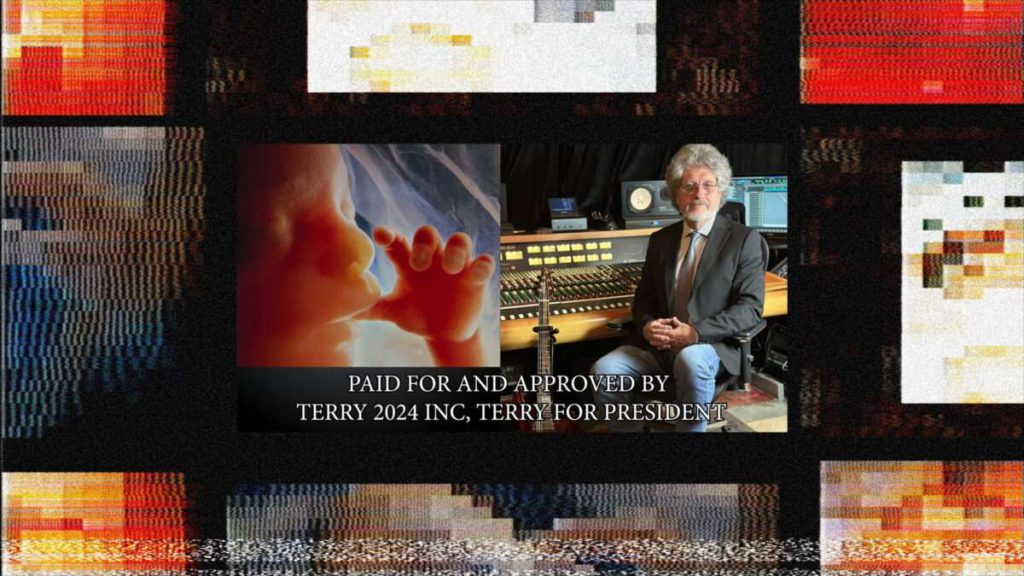Many commentators, especially progressives, feel that it’s simply too easy for people to say offensive or untrue things on TV or the internet and go uncorrected. Some feel that the Federal Communications Commission (FCC) should step in and do something about it. In this campaign cycle, we have a real-world example of what that would look like.
In a conversation with Semafor‘s David Weigel, the Constitution Party’s presidential candidate—Operation Rescue founder Randall Terry—detailed his plan to air graphic anti-abortion campaign ads in swing states. Terry already caused what he calls “an epic shitstorm” when one of his ads aired during a broadcast of ABC’s morning chat show The View: Over images of aborted fetuses, Terry’s voice-over decries “stupid celebrities and lying journalists,” pictures of whom he also displays, including all six hosts of The View. For their alleged support of abortion rights, Terry compares them to Nazi propagandists Joseph Goebbels and Leni Riefenstahl. Another ad uses imagery of racist lynchings from the 1920s along with images of aborted African American fetuses and says Democrats are “lynching black babies by abortion.”
Weigel notes that Terry’s plan involves “taking advantage of FCC rules that allow candidates to air messages that networks might otherwise refuse to take.”
Federal law imposes an “equal opportunities requirement”—commonly called the equal time rule—on television broadcast licensees, a rule the FCC enforces. “If any licensee shall permit any person who is a legally qualified candidate for any public office to use a broadcasting station,” the law stipulates, “he shall afford equal opportunities to all other such candidates for that office in the use of such broadcasting station.” The station is not required to provide candidates free air time unless it has already done so for one of their direct competitors; if one candidate purchases air time, the station must offer to sell an equal amount of time to the other candidates at the same rate. (The law makes exceptions for “bona fide” news broadcasts, documentaries, and interviews, as well as “on-the-spot coverage” of news events.)
Importantly for Terry, “broadcast stations are prohibited from censoring or rejecting political ads that are paid for and sponsored by legally qualified candidates,” per the FCC. This allows Terry to run his gruesome anti-abortion ads under the theory that he is a candidate for office and that they are part of his pitch to voters. As long as he pays the same rate as other candidates, the networks are not allowed to refuse.
Chicago’s ABC affiliate, WLS, even aired a segment during its news broadcast earlier this month, explaining that “by law, WLS-TV must air the ad,” as “Terry will be on the ballot in at least 12 states so has met the criteria to be considered a legally qualified candidate.”
In fact, Terry’s campaign seems to be little more than a means to gain access to unfiltered air time, with no intention of actually competing for presidential votes: “My mission is not to win,” he told the Wisconsin TV station WXOW. “My mission is to cause Kamala [Harris] to lose. That’s the mission.” Terry said he is targeting people ages 50–80, “who still consume their news and their entertainment on television,” with ads that are “designed to give them a crisis of conscience.”
Terry mounted a similar campaign in the 2012 Democratic presidential primaries so he could run an anti-abortion ad—again featuring photos of aborted fetuses—during the Super Bowl. During that race, the perennial satiric candidate Vermin Supreme glitter-bombed Terry at a candidate forum.
And yet many, typically on the political left, defend the equal time rule as necessary to achieve some level of fairness in political discourse. Some even say it should be expanded.
“Although rarely invoked today, the equal time rule requires broadcasting stations to afford equal opportunity in airtime to all legally qualified candidates who submit a request,” Sydney Snower wrote in 2021 for the Federal Communications Law Journal. “The FCC’s interpretation of the equal time rule currently excludes political debates. This allows speaking time disparities to occur among candidates without penalty.” Snower, who is now an attorney at the prestigious white shoe law firm Quinn Emmanuel Urquhart & Sullivan, then “suggests that the FCC strengthen the equal time rule by broadening its scope and application to the political debate arena.”
“Online targeted political ads create enormous opportunities for undetected abuse,” Mark MacCarthy argued in a 2020 Forbes piece. “A better way to deal with false or misleading candidate ads would be to require social media companies to provide opposing candidates with an option to reach the same audience with corrective information. It would be an updated digital ‘equal time’ rule for twentieth century political campaigns.”
But as Terry’s campaign demonstrates, there is no “good faith” requirement under the equal time rule—federal regulations cannot judge a person’s heart. In fact, the equal time rule creates a scenario in which someone like Terry can game the system, wherein meeting a base set of criteria grants unfettered access to disseminate a message, even against the wishes of whoever owns the outlets he’s using.
A similar sentiment underlies calls for reinstituting the Fairness Doctrine, a defunct FCC rule that gave the agency the power to require “reasonable opportunity for discussion of conflicting views.” Under President Ronald Reagan, the FCC repealed the Fairness Doctrine, ushering in an era of opinionated commentators whose stations no longer needed to worry that the government would consider their broadcasts unbalanced.
The Fairness Doctrine and the FCC’s equal time rule both originated in the early broadcast era, and while they are not the same, they are often conflated—perhaps because they both stem from the supposition that policing speech in the interest of “fairness” is the federal government’s job. As Randall Terry is willing to demonstrate, this allows people to hijack the airwaves and air whatever they’d like, with little more than a bad-faith claim of aspiring to higher office.
Terry should, of course, have the right to air his ad in venues that don’t object to it. And indeed, without government intervention, the two ads mentioned above are available to watch on YouTube and Vimeo, respectively. Terry would almost certainly be welcome on Rumble, the YouTube competitor that touts its dedication to free speech. Meanwhile, cable outlets may be free to reject ads like Terry’s. But over-the-air broadcasts, as usual, are overregulated.
The post This Activist Uses the FCC To Shoehorn Gruesome Anti-Abortion Ads Onto the Air appeared first on Reason.com.






